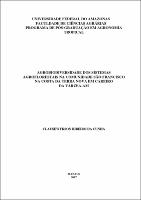| ???jsp.display-item.social.title??? |


|
Please use this identifier to cite or link to this item:
https://tede.ufam.edu.br/handle/tede/6170| ???metadata.dc.type???: | Dissertação |
| Title: | Agrobiodiversidade dos sistemas agroflorestais na Comunidade São Francisco na costa da terra nova em Careiro da Várzea-AM |
| ???metadata.dc.creator???: | Cunha, Clausewykson Ribeiro da  |
| ???metadata.dc.contributor.advisor1???: | Fraxe, Therezinha de Jesus Pinto |
| ???metadata.dc.contributor.referee1???: | Castro, Albejamere Pereira de |
| ???metadata.dc.contributor.referee2???: | Pinto, Ernesto Oliveira Serra |
| ???metadata.dc.description.resumo???: | A agrobiodiversidade amazônica possui características peculiares que a diferenciam das demais regiões brasileiras, devido às formas específicas de conservação dos recursos naturais e devido à expressividade do saber ambiental amazônico, gerado e perpassado por centenas de gerações. Nesse sentido, o objetivo desta pesquisa foi caracterizar a agrobiodiversidade dos sistemas agroflorestais da comunidade São Francisco, localizada no município Careiro da Várzea, no estado do Amazonas através da identificação das principais espécies cultivadas nos sistemas agroflorestais, a descrição do manejo e conservação dos recursos vegetais pelas populações locais e a análise do valor de uso das espécies por meio da percepção dos agricultores familiares da flora local. Foi utilizada a metodologia de aplicação de formulários e entrevista semiestrutura como subsidio na busca de dados. O estudo teve como modelagem a análise qualitativa onde as espécies vegetais encontradas foram categorizadas pelo valor de uso: alimentar, medicinal, aromática, condimentar, artesanal, madeireiro e outros (venda). Participaram da pesquisa 50 agricultores familiares. Os dados coletados foram analisados quantitativamente. As coordenadas geográficas dos pontos obtidos da área de estudo foram georreferenciados por meio de GPS (Global Position System) modelo Garmin Etrex 10 e processados no Programa Quantun Gis. A análise estatística foi referenciada pelo valor de uso das espécies vegetais e o valor de importância da biodiversidade, e também, se avaliou a dominância e diversidade das espécies por meio do índice de Simpson. Foram identificadas 41 espécies vegetais, distribuídas em 24 famílias, onde se destacaram as espécies hortícolas representando a maior atividade produtiva, com cerca de 70%, seguido das espécies medicinais e frutíferas. No manejo dos recursos vegetais foi observado nos agricultores familiares utilização de técnicas de capina, amontoa e o desbaste nas áreas de produção. A conservação das espécies vegetais foi realizada através do armazenamento das sementes e partes vegetativas das plantas que serão cultivadas para o próximo ano no período de seca. E no período de cheia os cultivos são realizados com a técnica de canteiros suspensos, mantendo a espécie vegetal na comunidade. Também houve o consumo de espécies animais de pequeno, médio e grande porte como peixe, frango e gado para a segurança alimentar na comunidade. |
| Abstract: | The Amazonian agrobiodiversity has peculiar characteristics that differentiate it from the other Brazilian regions, due to the specific forms of conservation of natural resources and due to the expressiveness of the Amazonian environmental knowledge, generated and pervaded by hundreds of generations. In this sense, the objective of this research was to characterize the agrobiodiversity of the agroforestry systems of the São Francisco community, located in Careiro da Várzea municipality, in the state of Amazonas through the identification of the main species cultivated in agroforestry systems, a description of the management and conservation of vegetal resources by the local populations and the analysis of the use value of the species through the perception of the family farmers of the local flora. It was used the methodology of application of forms and semistructure interview as subsidy in the search of data. The modeling was the qualitative analysis where the plant species found were categorized by the value of use: food, medicinal, aromatic, spice, handmade, timber and others (sale). Fifty family farmers participated in the survey. The data collected were analyzed quantitatively. The geographic coordinates of the points obtained from the study area were georeferenced using GPS (Global Position System) model Garmin Etrex 10 and processed in the Quantun Gis Program. The statistical analysis was based on the value of use of the plant species and the importance value of biodiversity, and also the dominance and diversity of the species was evaluated using the Simpson index. A total of 41 plant species were identified, distributed in 24 families, where the vegetable species were the most productive, with about 72%, followed by medicinal and fruit species. In the management of the vegetal resources was observed in the familiar farmers use of techniques of weeding, heaping and the thinning in the production areas. The conservation of plant species was carried out by storing the seeds and vegetative parts of the plants that will be cultivated for the next year in the dry season. And in the full season the cultivations were carried out with the technique of suspended beds, maintaining the vegetal species in the community. There was also consumption of small, medium and large animal species such as fish, chicken and cattle for in food security in the community. |
| Keywords: | Agrobiodiversidade Agroecossistemas Sistemas Agroflorestais Agricultura Familiar |
| ???metadata.dc.subject.cnpq???: | CIÊNCIAS AGRÁRIAS: AGRONOMIA |
| Language: | por |
| ???metadata.dc.publisher.country???: | Brasil |
| Publisher: | Universidade Federal do Amazonas |
| ???metadata.dc.publisher.initials???: | UFAM |
| ???metadata.dc.publisher.department???: | Faculdade de Ciências Agrárias |
| ???metadata.dc.publisher.program???: | Programa de Pós-graduação em Agronomia Tropical |
| Citation: | CUNHA, Clausewykson Ribeiro da. Agrobiodiversidade dos sistemas agroflorestais na Comunidade São Francisco na costa da terra nova em Careiro da Várzea-AM. 2017. 52 f. Dissertação (Mestrado em Agronomia Tropical) - Universidade Federal do Amazonas, Manaus, 2017. |
| ???metadata.dc.rights???: | Acesso Aberto |
| ???metadata.dc.rights.uri???: | http://creativecommons.org/licenses/by-nc-nd/4.0/ |
| URI: | http://tede.ufam.edu.br/handle/tede/6170 |
| Issue Date: | 7-Mar-2017 |
| Appears in Collections: | Mestrado em Agronomia Tropical |
Files in This Item:
| File | Description | Size | Format | |
|---|---|---|---|---|
| Dissertação_Clausewykson R. Cunha.pdf | 1.66 MB | Adobe PDF |  Download/Open Preview |
This item is licensed under a Creative Commons License





